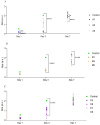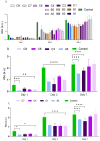Accelerated Simple Preparation of Curcumin-Loaded Silk Fibroin/Hyaluronic Acid Hydrogels for Biomedical Applications
- PMID: 36771806
- PMCID: PMC9919302
- DOI: 10.3390/polym15030504
Accelerated Simple Preparation of Curcumin-Loaded Silk Fibroin/Hyaluronic Acid Hydrogels for Biomedical Applications
Abstract
The development of new biomaterials from natural fibres in the field of biomedicine have attracted great interest in recent years. One of the most studied fibres has been silk fibroin produced by the Bombyx mori worm, due to its excellent mechanical properties and its biodegradability and bioavailability. Among the different biomaterials that can be prepared from silk fibroin, hydrogels have attracted considerable attention due to their potential use in different fields, such as scaffolding, cell therapy and biomedical application. Hydrogels are essentially a three-dimensional network of flexible polymer chains that absorb considerable amounts of water and can be loaded with drugs and/or cells inside to be used in a wide variety of applications. Here we present a simple sonication process for the preparation of curcumin-hyaluronic acid-silk fibroin hydrogels. Different grades of hydrogels were prepared by controlling the relative amounts of their components. The hydrogels were physically and morphologically characterised by Fourier transform infrared spectroscopy (FTIR), X-ray diffraction (XRD), thermogravimetric analysis (TGA) and field emission scanning electron microscopy (FESEM) and their biological activity was tested in terms of cell viability in a fibroblast cell line.
Keywords: cellular proliferation; curcumin; hyaluronic acid; hydrogel; silk fibroin.
Conflict of interest statement
The authors declare no conflict of interest.
Figures












References
Grants and funding
LinkOut - more resources
Full Text Sources

